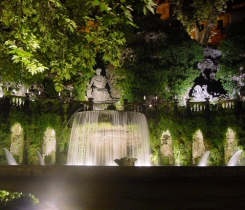The Ovate fountain (or Tivoli fountain)
The
Fountain of Ovate ![]() ,
said also the Fountain of Tivoli, is called this way from
1567 because of its shape.
,
said also the Fountain of Tivoli, is called this way from
1567 because of its shape.
It is a semicircular exedra with
a basin in the center which takes water from the top.
It has
some statues representing heroes of the mythology which exalt
the dynasty of d'Este and the greatness of Tivoli. It symbolically
represents the falls of Tivoli while the cliffs of the upper
part of the fountain represent the Tiburtin mountains. From
these " mountains" three rivers come down: Aniene,
Erculaneo and Albuneo. They are represented by three statues,
as always in Villa of Este.
The Albuneo river is represented by the Sibilla Albunea
with a child, Melicerte, son of the nymph Ino, who became
Leucotea then assimilated to the Sibilla Tiburtina. The
others two statues, beside this central statue, are placed
into two artificial caves. The fountain ![]() was designed by Pirro Logorio, but actually it was realized
by other artists like Curzio Maccarone, Giovanni Malanca,
Giovanni Battista della Porta and Della Vellita.
was designed by Pirro Logorio, but actually it was realized
by other artists like Curzio Maccarone, Giovanni Malanca,
Giovanni Battista della Porta and Della Vellita.
It is placed at the end of the avenue of the One
hundred Fountains, while at the beginning of it there
is the fountain "La Rometta".
This
one is another wonderful fountain placed there in order to
correspond to the principle of symmetry or contrast of the
parts (always respected in the Villa).
In fact, to a whatever artistic-decorative element, as for example a statue, a column, a fountain or a mythological figure, placed at the beginning of an avenue it corresponded another one at the opposite. So the avenue of the One hundred Fountains is delimited by the Fountain of Tivoli at one end and by the Fountain of Rome at the other one.
In this way, the falls of the river Aniene of Tivoli is opposed to the artistic beauties of Rome, as well as the natural drop of the river is opposed to the artistic greatness of the Roman monuments. Tivoli and Rome are therefore seen as rivals (actually the two cities have been fought several times) and they are represented as a Horse the first one and as a Lion the second one. It is interesting to remember that these two fighting animals had been already placed in the Fountain "Rometta" in 1607.
Surroundings
-
The Sacro Speco

An impressive complex of buildings which almost looks as if it is one with the surrounding rock...
To know more
-
Rocca Pia
Built on the place where Callisto II Borgia's Castle was situated...
-
Church of St.Peter
It was built on the rests of a roman villa...
Tivoli's attractions

Patrocinio Comune di Tivoli
Assessorato al Turismo




